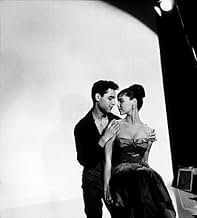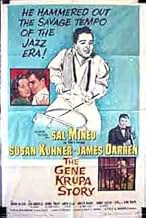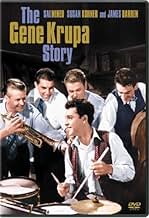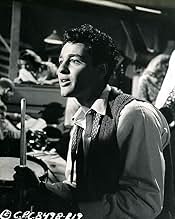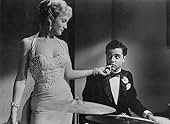Añade un argumento en tu idiomaBiopic of famous jazz drummer, Gene Krupa, who becomes a sensation but cannot handle success and life in the fast lane and ends-up broke, struggling with drugs and alcohol.Biopic of famous jazz drummer, Gene Krupa, who becomes a sensation but cannot handle success and life in the fast lane and ends-up broke, struggling with drugs and alcohol.Biopic of famous jazz drummer, Gene Krupa, who becomes a sensation but cannot handle success and life in the fast lane and ends-up broke, struggling with drugs and alcohol.
- Premios
- 1 premio y 1 nominación en total
Stanley Adams
- Bar Owner
- (sin acreditar)
Marie Ardell
- Minor Role
- (sin acreditar)
Candy Barr
- Stripper
- (sin acreditar)
Arthur Berkeley
- Stagehand
- (sin acreditar)
John Bleifer
- Father
- (sin acreditar)
Reseñas destacadas
Not historially accurate, but a great portrayal by Sal Mineo. He worked with Krupa for about 2 years before filming began. The only real flaw is that the music is a 1950's version of 1930's swing/jazz, and none of Krupa's hits of the 40's were really included. Nonetheless, the music is very good, with Mineo mimicing extremely accurately Krups's off screen drumming.
Biography of penultimate jazz drummer Krupa (played here with enthusiasm by young Sal Mineo) as he achieves fame and fortune for his unique talent, then squanders his success on alcohol, illicit substances and loose women. Mineo is sharp and authentic-looking in his impersonations of the frenetic, almost chaotic looking drumming, while Kohner is his antithesis, a placid, mature girl who despite his lack of judgment and indiscretions, sticks by him, ultimately resurrecting his career after he's incarcerated for narcotics possession (in spite of his protests "they weren't my reefers!"). She encourages him to learn to read music, while his fair-weather friends encourage him to party to excess, his grip on the sticks stutters and concerns grow for his well being.
Larry Dobkin is Krupa's cool-as-cucumber attorney, but the trio of girls assembled to tempt Mineo (principally youthful Craig and sultry Oliver) are welcome distractions from the musical numbers (which are superbly choreographed and not over represented). Darren isn't bad as his trumpet-playing concerned friend and future "Love Boat" captain Gavin McLeod is on deck in a small role as Krupa's brother.
The subject matter is handled with conservatism and the drug dependency issue isn't really explored in any detail (the scene in which he rejects Oliver's offer of a doobie is a little cheesy, surely even by the contemporary standards). Still it's a bit more than a casual theme, and this is more than just a string of musical numbers loosely bound in a biopic melodrama. Mineo's performance is well balanced, while Kohner is appropriately understated and the musical numbers more than compensate for any particular lack of dramatic intensity. Worth a look.
Larry Dobkin is Krupa's cool-as-cucumber attorney, but the trio of girls assembled to tempt Mineo (principally youthful Craig and sultry Oliver) are welcome distractions from the musical numbers (which are superbly choreographed and not over represented). Darren isn't bad as his trumpet-playing concerned friend and future "Love Boat" captain Gavin McLeod is on deck in a small role as Krupa's brother.
The subject matter is handled with conservatism and the drug dependency issue isn't really explored in any detail (the scene in which he rejects Oliver's offer of a doobie is a little cheesy, surely even by the contemporary standards). Still it's a bit more than a casual theme, and this is more than just a string of musical numbers loosely bound in a biopic melodrama. Mineo's performance is well balanced, while Kohner is appropriately understated and the musical numbers more than compensate for any particular lack of dramatic intensity. Worth a look.
Sal Mineo was a real so-so actor. Apart from his fresh, young looks, sweet face, deep eyes and athletic build, he was not more than a third rate version of some James Dean or even Elvis, who was a mediocre actor, too. Here, Sal tries to take on life of great late drummer (my personal musical favorite in jazz) Gane Krupa. Did Sal succeed? Nay, he did not. Gene was an affable, lovable, open-hearted man of integrity and skill. Sal is OK but not deeply convincing. Instead, he looks more like a talented, but hapless, selfish, spoiled man of some unripe masculinity. One thing is great for sure - Sal really knew how to play them drums well. Yes, real Gene Krupa recorded all the drum parts for the movie, but Sal mimicked them all with such a thrilling precision and skill that I, as a drummer myself, was awed. The love line is nothing more than a very typical 50's Hollywood kitsch palette of clichés and banality. Well, one more great thing is an outstanding jazz soundtrack with all the greats included. The film could have become a bigger and better thing, but all is jammed and packed in 100 minutes and the aftertaste is somewhat sour and bitter. Gene deserved a better impersonator, in fact. And the movie a better script.
Imagine that it is 1970 and they have just released "The Frank Sinatra Story" with then 20 year-old David Cassidy playing the Italian crooner from ages 17 through 47. If that sounds weird imagine that the production designer on the film never shows up and they film it as if everything from 1935 to 1965 looks (and everyone talks) like it is set in 1970. Finally imagine that to preserve the 1970's look, all the action takes place inside, with one short scene on an indoor sound stage with fake grass and trees.
That is essentially "The Gene Krupa Story", with bobby soxer heartthrob Sal Mineo replacing Cassidy, Krupa replacing Sinatra, and the look of 1959 replacing 1970. Mineo was the Cassidy of his generation, with about the same level of acting talent but harder working and more willing to take direction.
Like the imagined "Cassidy as Sinatra" film, the idea was to expand the target audience by including someone who would attract teen and pre-teen girls. In this "The Gene Krupa Story" was successful and the film had good box office. The downside was that big band fans generally considered the whole production laughable. My father was a huge Krupa fan and he hated this film with an unprecedented passion. In part for the cheap production design and in part because of Mineo and the reasons for his casting, but largely because of the many factual omissions and distortions. To him the only saving grace was that they used Krupa's actual drumming, to which Mineo is generally in sync although there are times when he is beating a tom and the sound is that of a cymbal.
Like most Hollywood bio movies ("The Lou Gerhig Story", "The Al Jolson Story", etc.) Krupa's mother was violently opposed to her son's ambitions, in this case she and her husband want him to be a priest. But he leaves the seminary to set out for New York with Eddie Sirota (James Darren) and Eddie's composer girlfriend, Ethel (Susan Kohner). After a rough three months Ethel is forced to take a job as a telephone operator and her romantic interest switches to Gene.
Gene's career takes off and he begins running with a fast crowd of 1930's musicians (who sound strangely like a Maynard G. Kreb's take on the 1950's beat scene). A jazz singer named Dorissa Dinell (Susan Oliver) connects him with some dope dealers and the film gets a lot like "Reefer Madness" (but with a 1959 setting). Which may account for a surreal montage of newspaper headlines chronicling his rise to national fame and his fall in a drug bust. There is even an "I told you so" phone call from mom. This has ramifications beyond Krupa as the entire jazz world is outed as dope fiends and corrupter of America's youth. When the chips are down, Dorissa bails on Gene with the classic exit line: "Now if you'll excuse me, I've got a town I'd better get out of." Gene is reduced to playing in strip clubs with other beatnik musicians wearing dark glasses. When it seems like he can't go on another day Ethel re- enters his life and things begin to break his way once again.
For the aging sequences Mineo could draw upon the example James Dean, who he worked with in both "Rebel Without a Cause" and "Giant". Dean was faced with the same challenge in "Giant" and Mineo's attempt here is clearly superior. So much so that what could have been the film's biggest liability is actually a strength. And Mineo successfully mimics Krupa distinctive drumming style and facial expressions, details that he worked on with Krupa himself. There are seven drum solo set pieces, mostly medium shots that capture the spirit if not the actual magic of a Krupa performance.
Susan Kohner shows considerable range in two of her 1959 films, this one and "Imitation of Life". Here she will remind you of Eva Marie Saint's "On the Waterfront" character, a considerable contrast with the overwrought racially conflicted daughter she played in the other film. The likable James Darren (later to star in television's "The Time Tunnel") is a better singer than an actor. His scenes with Mineo are pretty awful, certainly the film's worst moments, and the fault does not lie with Mineo who tends to play up or down to the level of whoever he shares a scene. The hard working Mineo simply did not have enough talent or training to salvage a scene gone bad and really needed to be surrounded by a strong cast to help him sell his characterizations. Susan Oliver ("Butterfield 8") gets the best role and has a lot of fun with her character, benefiting from having almost all of the film's good lines. "Snow me again, junior, because I didn't quite get your drift." When I see her in a film I am always reminded of her classic guest-staring appearance as the sizzlingly hot female prisoner Barney and Andy have to cope with in episode 4-18 of "The Andy Griffith Show".
Then again, what do I know? I'm only a child.
That is essentially "The Gene Krupa Story", with bobby soxer heartthrob Sal Mineo replacing Cassidy, Krupa replacing Sinatra, and the look of 1959 replacing 1970. Mineo was the Cassidy of his generation, with about the same level of acting talent but harder working and more willing to take direction.
Like the imagined "Cassidy as Sinatra" film, the idea was to expand the target audience by including someone who would attract teen and pre-teen girls. In this "The Gene Krupa Story" was successful and the film had good box office. The downside was that big band fans generally considered the whole production laughable. My father was a huge Krupa fan and he hated this film with an unprecedented passion. In part for the cheap production design and in part because of Mineo and the reasons for his casting, but largely because of the many factual omissions and distortions. To him the only saving grace was that they used Krupa's actual drumming, to which Mineo is generally in sync although there are times when he is beating a tom and the sound is that of a cymbal.
Like most Hollywood bio movies ("The Lou Gerhig Story", "The Al Jolson Story", etc.) Krupa's mother was violently opposed to her son's ambitions, in this case she and her husband want him to be a priest. But he leaves the seminary to set out for New York with Eddie Sirota (James Darren) and Eddie's composer girlfriend, Ethel (Susan Kohner). After a rough three months Ethel is forced to take a job as a telephone operator and her romantic interest switches to Gene.
Gene's career takes off and he begins running with a fast crowd of 1930's musicians (who sound strangely like a Maynard G. Kreb's take on the 1950's beat scene). A jazz singer named Dorissa Dinell (Susan Oliver) connects him with some dope dealers and the film gets a lot like "Reefer Madness" (but with a 1959 setting). Which may account for a surreal montage of newspaper headlines chronicling his rise to national fame and his fall in a drug bust. There is even an "I told you so" phone call from mom. This has ramifications beyond Krupa as the entire jazz world is outed as dope fiends and corrupter of America's youth. When the chips are down, Dorissa bails on Gene with the classic exit line: "Now if you'll excuse me, I've got a town I'd better get out of." Gene is reduced to playing in strip clubs with other beatnik musicians wearing dark glasses. When it seems like he can't go on another day Ethel re- enters his life and things begin to break his way once again.
For the aging sequences Mineo could draw upon the example James Dean, who he worked with in both "Rebel Without a Cause" and "Giant". Dean was faced with the same challenge in "Giant" and Mineo's attempt here is clearly superior. So much so that what could have been the film's biggest liability is actually a strength. And Mineo successfully mimics Krupa distinctive drumming style and facial expressions, details that he worked on with Krupa himself. There are seven drum solo set pieces, mostly medium shots that capture the spirit if not the actual magic of a Krupa performance.
Susan Kohner shows considerable range in two of her 1959 films, this one and "Imitation of Life". Here she will remind you of Eva Marie Saint's "On the Waterfront" character, a considerable contrast with the overwrought racially conflicted daughter she played in the other film. The likable James Darren (later to star in television's "The Time Tunnel") is a better singer than an actor. His scenes with Mineo are pretty awful, certainly the film's worst moments, and the fault does not lie with Mineo who tends to play up or down to the level of whoever he shares a scene. The hard working Mineo simply did not have enough talent or training to salvage a scene gone bad and really needed to be surrounded by a strong cast to help him sell his characterizations. Susan Oliver ("Butterfield 8") gets the best role and has a lot of fun with her character, benefiting from having almost all of the film's good lines. "Snow me again, junior, because I didn't quite get your drift." When I see her in a film I am always reminded of her classic guest-staring appearance as the sizzlingly hot female prisoner Barney and Andy have to cope with in episode 4-18 of "The Andy Griffith Show".
Then again, what do I know? I'm only a child.
Competent, slick and well photographed, but fairly banal treatment of the famous drummer.
Almost no attempt is made to visually set the story in the twenties and thirties. Thus, the film abounds in an abundance of visual anachronisms, including fifties architecture, decor, and clothing, (Misses Kohner and Craig wear Dior style shirtwaist dirndls throughout, whilst Miss Oliver wears Capri style cocktail pants!--nowhere is there a cloche hat, aigrette or dropped waist). Only slight sartorial concessions are made for the men, (a few bowler hats and double breasted vests)
These inaccuracies no doubt accrue from the fact that the picture is being pitched wholesale to the 1959 teen audience and not to their parents.
For his part, Mr. Mineo does exceedingly well, though at times he does lapse into hipster posturing, (in his finger pointing angry scenes he appears to be imitating Ben Gazzara). Given his extreme youth, however, he demonstrates more poise and depth than his teen idol peers. The only really embarrassing moments come when he is depicted as a cassock clad seminarian in prayer.
If nothing else, this film provides your only chance to see Sal Mineo in spats.
Almost no attempt is made to visually set the story in the twenties and thirties. Thus, the film abounds in an abundance of visual anachronisms, including fifties architecture, decor, and clothing, (Misses Kohner and Craig wear Dior style shirtwaist dirndls throughout, whilst Miss Oliver wears Capri style cocktail pants!--nowhere is there a cloche hat, aigrette or dropped waist). Only slight sartorial concessions are made for the men, (a few bowler hats and double breasted vests)
These inaccuracies no doubt accrue from the fact that the picture is being pitched wholesale to the 1959 teen audience and not to their parents.
For his part, Mr. Mineo does exceedingly well, though at times he does lapse into hipster posturing, (in his finger pointing angry scenes he appears to be imitating Ben Gazzara). Given his extreme youth, however, he demonstrates more poise and depth than his teen idol peers. The only really embarrassing moments come when he is depicted as a cassock clad seminarian in prayer.
If nothing else, this film provides your only chance to see Sal Mineo in spats.
¿Sabías que...?
- CuriosidadesWhen the film opened in Krupa's hometown of Chicago at the Schiller Theatre on January 15, 1960 both Gene Krupa and Sal Mineo were on hand to greet the public and sign "fan fotos."
- PifiasWhen we see Gene at his penthouse on Central Park, at the party one of the guests is Bix Beiderbecke. Bix died in 1931 and only ever played with Gene Krupa in Chicago. By the time Krupa made it in New York, Bix had already died.
- Citas
Gene Krupa: Who's the snake charmer?
Dorissa Dinell: Anita O'Day. Not bad - if you like talent.
- ConexionesFeatured in Historia policial: The Broken Badge (1978)
Selecciones populares
Inicia sesión para calificar y añadir a tu lista para recibir recomendaciones personalizadas
Detalles
- Duración1 hora 41 minutos
- Color
- Relación de aspecto
- 1.66 : 1
Contribuir a esta página
Sugerir un cambio o añadir el contenido que falta

Principal laguna de datos
By what name was The Gene Krupa Story (1959) officially released in India in English?
Responde


